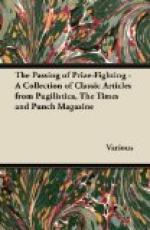You need not say anything more now. The discussion will get along beautifully without you, for you will have drawn, (1), the man who very much prefers E.C., which he warrants to kill at a distance no other powder can attain to; (2), the man who uses E.C. or Schultze for his right barrel, and always puts a black-powder cartridge into his left; (3), the detester of innovations, who means to go on using the good old black-powder for both barrels as long as he lives; and (4), the man who is trying an entirely new patent powder, infinitely superior to anything else ever invented, and is willing to give everybody, not only the address of the maker, but half a dozen cartridges to try.
You cannot make much of “charges” of powder. Good shots are dogmatic on the point, and ordinary shots don’t bother their heads about it, trusting entirely to the man who sells them their cartridges. Still you might throw out, here and there, a few words about “drams” and “grains.” Only, above all things, be careful not to mention drams in connection with anything but black powder, nor grains, except with reference to Schultze or E.C. A laboriously-acquired reputation as a scientific shot has been known to be ruined by a want of clearness on this important point.
“Shot.” Conversationally much more valuable than powder. “Very few people agree,” says a well-known authority; “as to what is the best size of shot to use, and many forget that the charge which will suit one gun, and one description of game, will not do as well for another. Usually, one gun will shoot better one size of shot than will another, and we may safely say, that large bores shoot large shot better than do smaller bores.” This last sentence has the beautiful ring of a profound truism. Lay it by for use, and bring it out with emphasis in the midst of such disagreement and forgetfulness as are here alluded to. “If a shooter is a good shot,” says the same classic, “he may use No. 6 early in the season, and only for partridges—afterwards, nothing but No. 5. To the average shot, No. 6 throughout the season.” This sounds dreadfully invidious. If a good shot cannot kill grouse with No. 6, how on earth is a merely average shot to do the trick? But, in these matters, the conversationalist finds his opportunity. Only they must not be pushed too far. There was once a party of genial, light-hearted friends, who went out shooting. Early in the day, slight differences of opinion made themselves observed with reference to the size of shot. Lunch found them still more or less good-tempered, but each obstinately determined not to give way even by a fraction on the point under discussion.
[Illustration]




